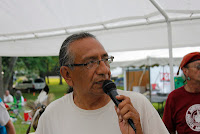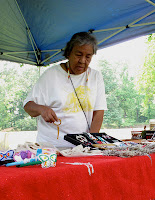Dancing with the Stars: Powwow in Ohio’s Celestial Earthworks
Published in Indian Country Today in June 2012. For more on topics like this, see my book, American Apartheid: The Native American Struggle....
The largest geometric earthworks complex in the world, the Newark Earthworks was built between 100 BC and 400 AD by virtuosic astronomers and geometers who encoded the complex 18.61-year cycle of the moon in the placement of giant earthen shapes, including several circles, a square, an octagon and an ellipse. Originally, there were hundreds of such complexes around Ohio, said Marti Chaatsmith, Comanche/Choctaw and program director of the Newark Earthworks Center. Nowadays, after centuries of agricultural plowing and development, just a few remain. No one knows what the ancient builders called themselves or even what happened to them after they completed their vast construction project; archaeologists refer to them as “the Hopewell culture,” after a farm where artifacts were found in the 19th century.
 That sentiment endures. “We’re here to celebrate
abundance and all those who contributed to our lives today,” emcee Guy Jones, Hunkpapa
Lakota (left), told the gathering as the dancers wound around the arena. The event had a Lakota-Dakota accent. “The protocol this weekend—the host drum Chaske Hotaine [below], the songs, the grand entry—is Northern Plains,” said Jones, a co-founder of the Miami Valley Council for Native Americans, in Dayton. There was a strong showing of folks from those communities, who are among the many Native people who emigrated to Ohio over the years, during the 1950s relocation era and afterward to find work. They were not the only nations represented, though. A quick survey revealed Seminole, Navajo, Inca, Northern Cheyenne, Blackfoot and Cherokee participants. People gossiped, traded stories of home and met old friends.
That sentiment endures. “We’re here to celebrate
abundance and all those who contributed to our lives today,” emcee Guy Jones, Hunkpapa
Lakota (left), told the gathering as the dancers wound around the arena. The event had a Lakota-Dakota accent. “The protocol this weekend—the host drum Chaske Hotaine [below], the songs, the grand entry—is Northern Plains,” said Jones, a co-founder of the Miami Valley Council for Native Americans, in Dayton. There was a strong showing of folks from those communities, who are among the many Native people who emigrated to Ohio over the years, during the 1950s relocation era and afterward to find work. They were not the only nations represented, though. A quick survey revealed Seminole, Navajo, Inca, Northern Cheyenne, Blackfoot and Cherokee participants. People gossiped, traded stories of home and met old friends.
 “It’s a chance to see people who live elsewhere in
Ohio and to make sure our children stay in touch with our culture,” said Irving
Standing Soldier, Oglala Lakota, who introduced his sons Ken and Sam. “I took
my culture for granted, since I grew up on Pine Ridge, but my children are
growing up in Ohio, so coming here is important for them.”
“It’s a chance to see people who live elsewhere in
Ohio and to make sure our children stay in touch with our culture,” said Irving
Standing Soldier, Oglala Lakota, who introduced his sons Ken and Sam. “I took
my culture for granted, since I grew up on Pine Ridge, but my children are
growing up in Ohio, so coming here is important for them.”
 Some people were there to appreciate Native ways. A non-Native
vendor of homemade jerky had brought his grandchildren and said the powwow was
a great way to introduce them to another culture. “His comfort with the event
says a lot,” said Chaatsmith. “We at NEC have worked hard to bring Native
issues and people to the public’s attention, and it’s good to know the result
is they’re perceived positively.”
Some people were there to appreciate Native ways. A non-Native
vendor of homemade jerky had brought his grandchildren and said the powwow was
a great way to introduce them to another culture. “His comfort with the event
says a lot,” said Chaatsmith. “We at NEC have worked hard to bring Native
issues and people to the public’s attention, and it’s good to know the result
is they’re perceived positively.”
A rainy night gave way to a bright, sunny day for the
opening of the 30th annual Selma Walker Memorial Day Weekend powwow,
sponsored by the Native American Indian Center of Central Ohio (NAICCO), in
Columbus. This year’s location was extraordinary, emphasizing the deep history
and powerful spiritual connections of Native people in
Ohio. As head veteran Richard Brings Them, Hunkpapa Lakota, led the grand entry
into the arena, the brilliant colors of the dancers’ regalia stood out against
the grass-covered earthen walls of the nearby Great Circle, shown below, a 30-acre enclosure
that’s part of the 2,000-year-old Newark Earthworks, in Newark and Heath, Ohio.
“This our first spring powwow
here,” said Carol Welsh, Sisseton-Wahpeton Oyate, NAICCO director and an organizer
of the three-day event (below with Richard Shields, director of Ohio State University's Newark Earthworks Center). “It’s an honor to be at the Great Circle, to bring
people together to feel good about this amazing site and each other.”
The largest geometric earthworks complex in the world, the Newark Earthworks was built between 100 BC and 400 AD by virtuosic astronomers and geometers who encoded the complex 18.61-year cycle of the moon in the placement of giant earthen shapes, including several circles, a square, an octagon and an ellipse. Originally, there were hundreds of such complexes around Ohio, said Marti Chaatsmith, Comanche/Choctaw and program director of the Newark Earthworks Center. Nowadays, after centuries of agricultural plowing and development, just a few remain. No one knows what the ancient builders called themselves or even what happened to them after they completed their vast construction project; archaeologists refer to them as “the Hopewell culture,” after a farm where artifacts were found in the 19th century.
“Like other significant structures around the world,
the place itself has a spiritual connection. Having the powwow here reinforces
the spiritual bond,” said Welsh, whose mother, Selma Walker, founded NAICCO in 1975.
At first, the organization helped Native people new to the area—assisting
with everything from finding employment to enrolling kids in school. “Then my
mother felt the community needed to celebrate as well.”
 That sentiment endures. “We’re here to celebrate
abundance and all those who contributed to our lives today,” emcee Guy Jones, Hunkpapa
Lakota (left), told the gathering as the dancers wound around the arena. The event had a Lakota-Dakota accent. “The protocol this weekend—the host drum Chaske Hotaine [below], the songs, the grand entry—is Northern Plains,” said Jones, a co-founder of the Miami Valley Council for Native Americans, in Dayton. There was a strong showing of folks from those communities, who are among the many Native people who emigrated to Ohio over the years, during the 1950s relocation era and afterward to find work. They were not the only nations represented, though. A quick survey revealed Seminole, Navajo, Inca, Northern Cheyenne, Blackfoot and Cherokee participants. People gossiped, traded stories of home and met old friends.
That sentiment endures. “We’re here to celebrate
abundance and all those who contributed to our lives today,” emcee Guy Jones, Hunkpapa
Lakota (left), told the gathering as the dancers wound around the arena. The event had a Lakota-Dakota accent. “The protocol this weekend—the host drum Chaske Hotaine [below], the songs, the grand entry—is Northern Plains,” said Jones, a co-founder of the Miami Valley Council for Native Americans, in Dayton. There was a strong showing of folks from those communities, who are among the many Native people who emigrated to Ohio over the years, during the 1950s relocation era and afterward to find work. They were not the only nations represented, though. A quick survey revealed Seminole, Navajo, Inca, Northern Cheyenne, Blackfoot and Cherokee participants. People gossiped, traded stories of home and met old friends. “It’s a chance to see people who live elsewhere in
Ohio and to make sure our children stay in touch with our culture,” said Irving
Standing Soldier, Oglala Lakota, who introduced his sons Ken and Sam. “I took
my culture for granted, since I grew up on Pine Ridge, but my children are
growing up in Ohio, so coming here is important for them.”
“It’s a chance to see people who live elsewhere in
Ohio and to make sure our children stay in touch with our culture,” said Irving
Standing Soldier, Oglala Lakota, who introduced his sons Ken and Sam. “I took
my culture for granted, since I grew up on Pine Ridge, but my children are
growing up in Ohio, so coming here is important for them.”
The three Standing Soldiers were relaxing in the
shade of Faye Yellow Eagle’s crafts booth, below. “Our children and grandchildren
dance, thanks to events like this,” agreed Yellow Eagle, Sicangu Lakota, as she
placed beaded earrings, moccasins and other handmade items on a table.
 Some people were there to appreciate Native ways. A non-Native
vendor of homemade jerky had brought his grandchildren and said the powwow was
a great way to introduce them to another culture. “His comfort with the event
says a lot,” said Chaatsmith. “We at NEC have worked hard to bring Native
issues and people to the public’s attention, and it’s good to know the result
is they’re perceived positively.”
Some people were there to appreciate Native ways. A non-Native
vendor of homemade jerky had brought his grandchildren and said the powwow was
a great way to introduce them to another culture. “His comfort with the event
says a lot,” said Chaatsmith. “We at NEC have worked hard to bring Native
issues and people to the public’s attention, and it’s good to know the result
is they’re perceived positively.”
Warm community connections make the NAICCO event
traditional, according to Welsh. “It’s the original sense of powwow. We have
contests, but they don’t predominate.” One event during the weekend was a 5-K
walk, from the Great Circle to a part of the earthworks complex called the
Ellipse, but the goal wasn’t winning. “It’s a sacred walk,” said Welsh. “We walk
on ground our ancestors traversed, and we stop for prayers, so it’s about both
spiritual and physical health.”
Walking, dancing, singing and simply being at the ancient
earthworks site was a manifestation of continuity, said Welsh: “We are grateful
for life and the gifts of the earth. We are grateful we have survived.”
Text c. Stephanie Woodard; photographs c. Stephanie Woodard (2) and Joseph Zummo (4).
Text c. Stephanie Woodard; photographs c. Stephanie Woodard (2) and Joseph Zummo (4).


